These next ten years are going to be packed with technological improvements bringing us closer to an utopian self-driving future. We are going to see some big announcements coming from big and small players alike. In this article, I discuss the automotive technologies that I?m most looking forward to in the next 10 years. Feel free to comment below on the technologies you?re anticipating most.
History has given us a few revolutions of automotive technology. From Nicolas-Joseph Cugnot building the first steam powered automobile in 1769, many people have contributed to where we are now. Karl Benz created the first ?production? vehicle in 1885, and Henry Ford invented the automobile assembly line to create the first ?mass-production? vehicle, the Ford Model T.
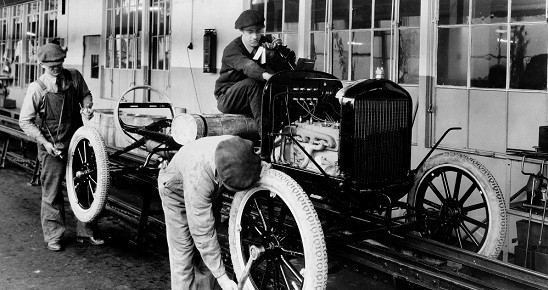 Ford?s Model T Assembly Line (source)
Ford?s Model T Assembly Line (source)
The first few revolutions of automobile technology came about as a necessity for a ?better horse.? Vehicle makers were simply trying to create a sustainable automobile that could standardize the world on driving. At some point, not long after Ford?s Model T, automakers shifted focus to besting one another on their automobile?s speed, power, luxury, and performance. Automakers realized they could show off how much better they were than their competition by creating better race cars, and beating each other on the track. This led to an explosion of new automotive technology. Almost all vehicle advancements that makes cars safer, faster, and higher performance are steeped in racing.
 Ferrari LaFerrari Aerodynamic Elements Taken from F1 Race Car (source)
Ferrari LaFerrari Aerodynamic Elements Taken from F1 Race Car (source)
The era we?re currently in consists of the race for the perfect autonomous electric vehicle. Most of the technologies I?ll discuss below are relevant to this. The metrics people care about are no longer related to who creates the fastest car, but rather who creates the safest, most comfortable, and most economical.
We?ll dive into each technology I?m most anticipating, but here?s the overview:
- Level 3/4 Autonomy
- Micromobility
- Smaller, More Efficient Electric Motors
- Solid State Batteries
- Electric Charging Technology
- Sensors for Perception
- Wireless Technology
- Automotive Materials and Manufacturing Processes
- Fully-Active Suspension
- Purpose-Built Enabling Technologies
1. Level 3/4 Autonomy
 Waymo?s Autonomous Vehicles (source)
Waymo?s Autonomous Vehicles (source)
I think it goes without saying that we?re all very much looking forward to the day when we can hop in a driverless car to get chauffeured to work. Accidents will be virtually eliminated. We?ll be able to do work while waiting in traffic, if there is traffic anymore. There will be no more drunk driving incidents. Cars won?t sit idly by in parking garages or on streets, so we?ll have more room for infrastructure.
We?re not quite there yet though. Some speculate we?re 6 years out, some say 13, and some say we?re 50. If I were a betting man, I?d put it on 2030 when you?ll be able to hail a driverless taxi in select cities, just like you do an Uber today. But what needs to happen, technologically, for this to happen? Of course, regulation and legal woes will inevitably slow the adoption of self-driving-cars down, but what?s left from a technology standpoint?
Well, where are we now? We have vehicular subsystems that are capable of controlling the vehicle autonomously in very limited and brief situations, that we typically refer to as ?Advanced Driver-Assistance Systems.? These include Adaptive Cruise Control, Parallel Parking Capability, and Collision Avoidance. This is not ?full,? or general autonomy, but rather what the Society of Automotive Engineers (SAE) deem Level 0, Level 1, and even Level 2 Autonomy:
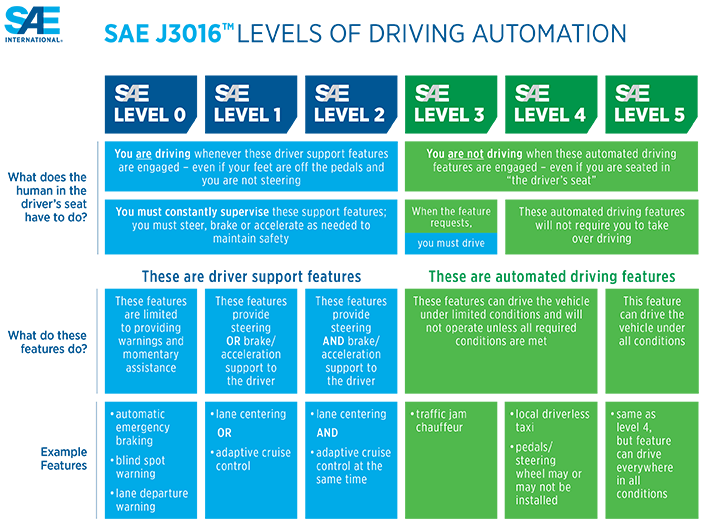 SAE ?Levels of Driving Automation? Chart, December 2018 (source)
SAE ?Levels of Driving Automation? Chart, December 2018 (source)
In order to have Level 3 or Level 4 autonomy, the vehicle must be able to make decisions on its own. Some companies are approaching this capability in their Level-3 ?mule? vehicles, like Waymo, Cruise, Uber, Lyft, Argo AI, Voyage, etc. But these mule vehicles all have a safety driver and are not production ready. What?s keeping them from it?
For one, there isn?t enough ?categorized data? available to teach their cars how to drive in millions of different corner case scenarios. By categorized data, we mean images and LiDAR/Radar point clouds that have labels with their contents and location of their contents overlaying the image. For example, a picture of a stop sign might be categorized as ?Stop Sign located at top left-hand corner of image.? Self-Driving Car companies have many people staffed to take and label data. Waymo has captured over 10 million miles of autonomous driving, and they are still working on labeling all their data to use to verify their autonomous systems. You might not realize it, but you help with this every time you solve a google CAPTCHA.
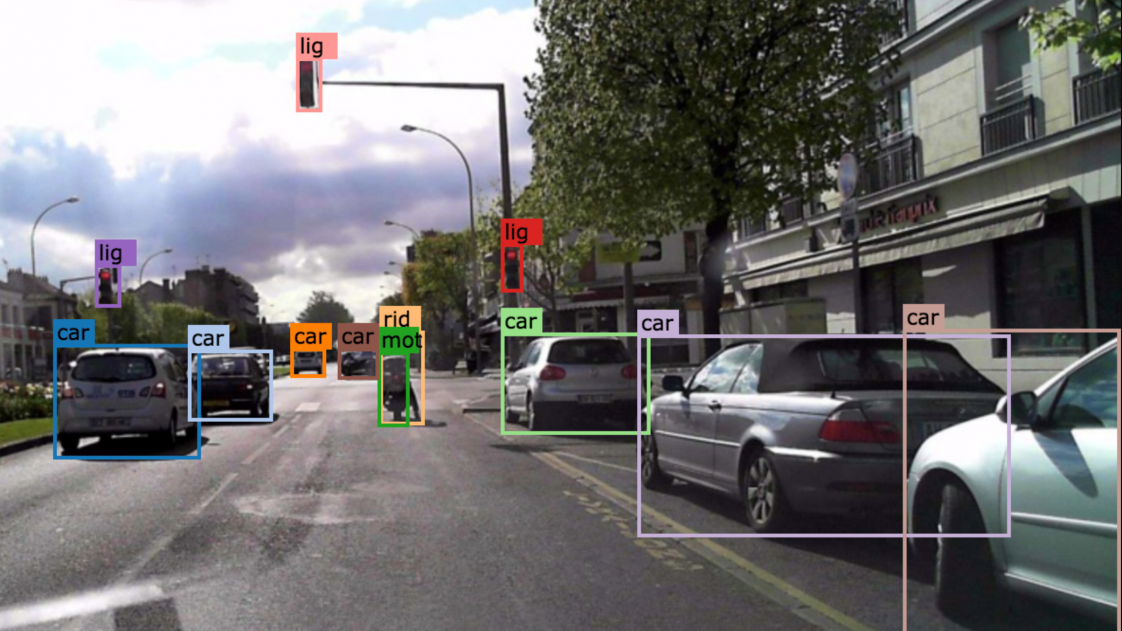 Example Categorized Data of Image and Labels (source)
Example Categorized Data of Image and Labels (source)
Another thing holding back full autonomy is that the algorithms determining where the vehicle should go based on inputs from the labeled data have not been fully optimized. This goes hand in hand with the data problem. Engineers are working on ways to make their algorithms execute faster while using less electrical energy. This is a multi-faceted problem of perception, localization, prediction, and path planning. Of course, they need to objectively prove that the decisions the vehicle makes is the correct one, and strategies for that are discussed in my article here.
Another piece of the pie is the hardware itself that the fully autonomous vehicle software runs on. Many companies are producing incredibly powerful embedded systems, like the NVIDIA Drive AGX Pegasus platform, capable of 320 Tera-Operations Per Second (TOPS), Intel?s EyeQ5, and Tesla?s HW3. The challenge is to create a compute platform capable of solving the complex algorithms defined above, in real-time, with minimal power draw. We will continue to see new chipset designs as the years roll on.
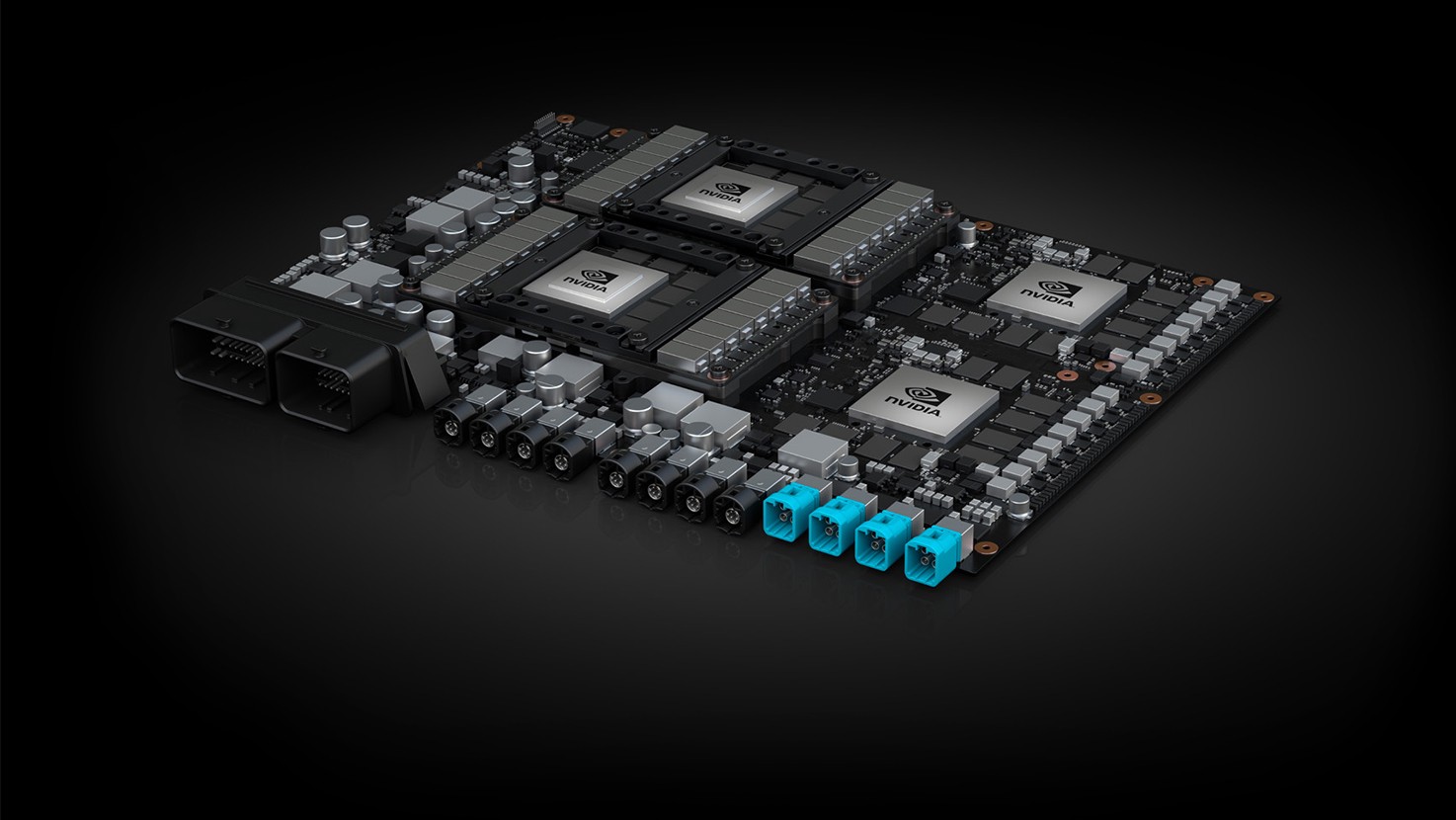 NVIDIA DRIVE AGX Self-Driving Car Platform (source)
NVIDIA DRIVE AGX Self-Driving Car Platform (source)
In the next few years leading up to full autonomy, we?ll see some impressive technological improvements in machine learning and data characterization that will enable us to validate the safety of the autonomous system.
2. Micromobility
 Electric Unicycle (source)
Electric Unicycle (source)
If you live in any major metropolitan area, you?ve seen your fair share of electric scooters and ebikes riding around. This form of transportation, that consists of travel on small vehicles under 15-mile trips, has gotten its own buzzword: micromobility.
There?s no formal definition of micromobility, but one of the lead thinkers in the space, Horace Dediu, considers them ?vehicles under 500 kg that do trips under 15 miles.? Horace even deduced that the entire total addressable market for ?micromobility? to be 30% larger than mobility in excess of 15-miles and in vehicles over 500 kg in his podcast (link).
This is also one of the fastest growing sectors of mobility in the world, with an explosion of scooters flooding our city streets and sidewalks in 2018.
 A Wild Flock of Bird Scooters (source)
A Wild Flock of Bird Scooters (source)
So, what can we expect over the next decade regarding technological advancements in micromobility? For one, we may see ?autonomous micromobility.? Microcars, like the Toyota i-ROAD concept, might be good candidates for an autonomous single-person taxi that can thread through cars like motorcycles or maybe even ride in the bike lane. The majority of ride hailing rides, scooters and ebikes, and taxi-rides are single-occupant rides. If we believe autonomous vehicles will indeed come into fruition, there?s no reason single-occupants in short rides need to be in 3000+ pound, 15-foot long, 6-foot wide metal machines. Autonomous micromobility would be a perfect way to alleviate congestion by maximally packaging humans on the road.
 Toyota i-Road Concept (source)
Toyota i-Road Concept (source)
Just last week, Uber announced a Micromobility Robotics division, building autonomous ebikes and scooters that will drive themselves to charging stations (Article).
Another interesting technological advancement possible with micromobility is accelerated road mapping. These scooters and ebikes are an excellent platform for which to connect sensors to, or leverage existing sensors in a mounted smart-phone, to better map the roads and sidewalks. These forms of transport may even be able to communicate, using V2V technology, road and traffic conditions to other vehicles.
3. Smaller, More Efficient Electric Motors
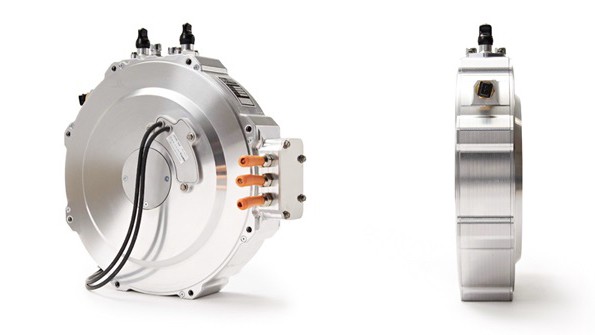 Compact, Axial Flux Electric Motor for Electric Airplane (source)
Compact, Axial Flux Electric Motor for Electric Airplane (source)
I?m making a bold assumption in this article that electric vehicles will be the way of the future. We?ll see some impressive improvements in the electrical motor world over the next few years, and maybe even some technologies we?ve long since discounted making it mainstream.
There are three main types of motors you?d potentially find in an electric vehicle: Brushed DC Motors, Brushless DC (BLDC) Motors, and AC Induction Motors. Most electric vehicles use BLDC or AC Induction motors because of their efficiency (% of electrical energy converted into mechanical energy), availability, lack of wear elements, and regenerative braking capability. There is a lot of debate about the tradeoffs between AC and BLDC motors, and Tesla?s blogging team has a great write-up on it (here), albeit slightly biased. Many people agree with the conclusion that we?ll see more AC 3-Phase Induction motors in high performance, purely Battery-Electric Vehicles in the future.
Motor suppliers want to enable OEMS to make less expensive, more efficient, longer lasting, further traveling, higher performance, quieter, more luxury, and better utilized electric vehicles. If the motor is smaller and more efficient, the vehicle itself can be smaller while maintaining the same interior volume. It would weigh less, so it?d then need a less powerful motor to have similar performance as a comparable vehicle with a larger motor. If the motor doesn?t have to be as powerful, fewer battery cells are needed for a higher amp-hour rating, thus making the vehicle lighter once again, or at the very least travel longer distances. Also, if the motors were smaller, the passenger or cargo space could be better utilized, since the interior space would not have to navigate around bulky drivetrain components. Vehicles might even look completely different than they do now, with additional leg room or seating arrangements, because designers would not be constrained by the traditional motor housing in the hood of the vehicle:
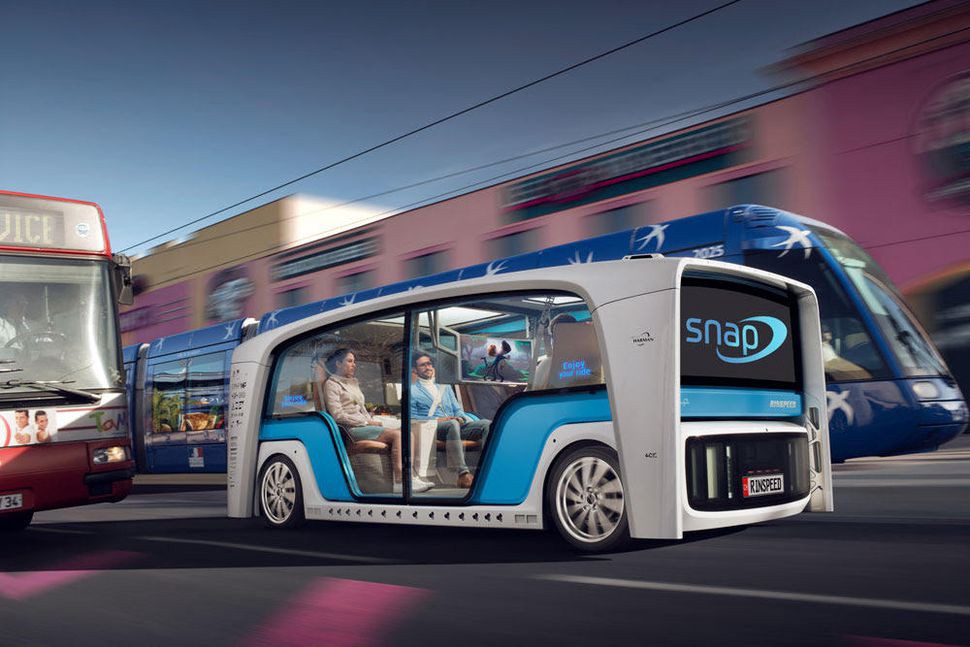 Rinspeed?s Snap Concept with Separate Chassis and Passenger Compartment (source)
Rinspeed?s Snap Concept with Separate Chassis and Passenger Compartment (source)
So what can we expect in this area? Many people have come up with all sorts of concepts for making smaller, lighter electric motors. Professor Martin Doppelbauer details his ?Asymmetric Motors? concept he built with his Formula SAE race team at Karlsruhe Institute of Technology in this article. NIO?s global startup working on e-propulsion systems, XPT, along with Punch Powertrain, are working on new high efficiency switched reluctance motors, different from Tesla?s Inverter-Driven AC induction motor, which is a more available motor type. Differences between the motor technology is detailed very well here.
Another promising technology is axial flux motors, where magnetic flux is produced along the axis instead of the sideways of the rotor in the motor. Magnax claims to have created an EV motor with ?unparalleled power density,? ?much lower overall weight and size,? and the highest efficiency in the market.
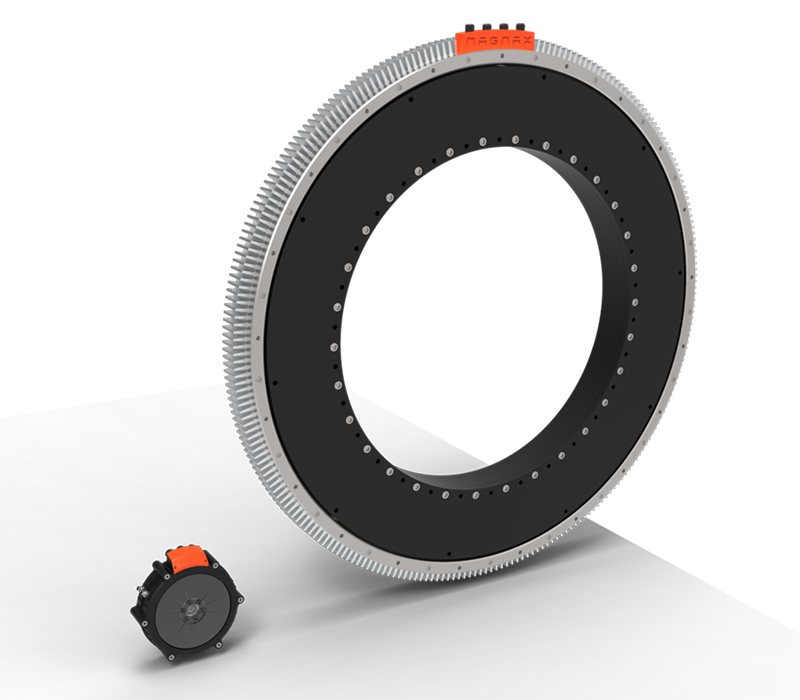 Scalable Architecture of Magnax?s Axial Flux Motor (source)
Scalable Architecture of Magnax?s Axial Flux Motor (source)
One of my personal favorite electric motor technologies has been around for quite some time. Electric direct drive in-wheel motors, or hub motors, are available today for many applications like scooters and ebikes. These have a few very intriguing benefits. For one, the vehicle could have independent control of each drive wheel?s speed, torque, traction control, and regenerative braking. Additionally, the motors can hide completely in the wheel of the vehicle, effectively taking up zero space and providing all the advantages described above. Lastly, it allows for modularity of the vehicle architecture, where packaging of passengers and luggage can take on new ideas.
The primary reasons hub motors are not utilized are because of concepts called ?unsprung weight? and ?Inertia.? Essentially, if a motor is in the hub of a wheel, the wheel is heavier. Heavier components are harder to accelerate. When a heavier wheel hits a bump, the suspension has to work extra hard to return that wheel to the ground. That extra work is translated into the chassis of the vehicle making for a very rough ride. Additionally, the rotational mass of the wheel increases, which has a significantly greater effect on the power needed to move the vehicle than if the mass of the body of the vehicle was increased by the same amount.
But these problems are seemingly surmountable. As we build more active suspension that can handle the extra weight of the unsprung mass, we could anticipate bumps and prevent a rough ride. Since manufacturers can put one motor in each wheel, the motors can be comparably smaller than other electric motors, and with the appropriate mechanical housing incorporating the wheel structure, the weight addition to the wheel might be negligible. Companies like Protean Electric are developing this technology as we speak.
Then there?s some even more crazy concepts. Like Michelin?s Active Wheel that was supposed to hit the roads in 2010, and the Orbis Ring-Driven Wheel, that combines the best of the hub motor, without the unsprung weight penalty:
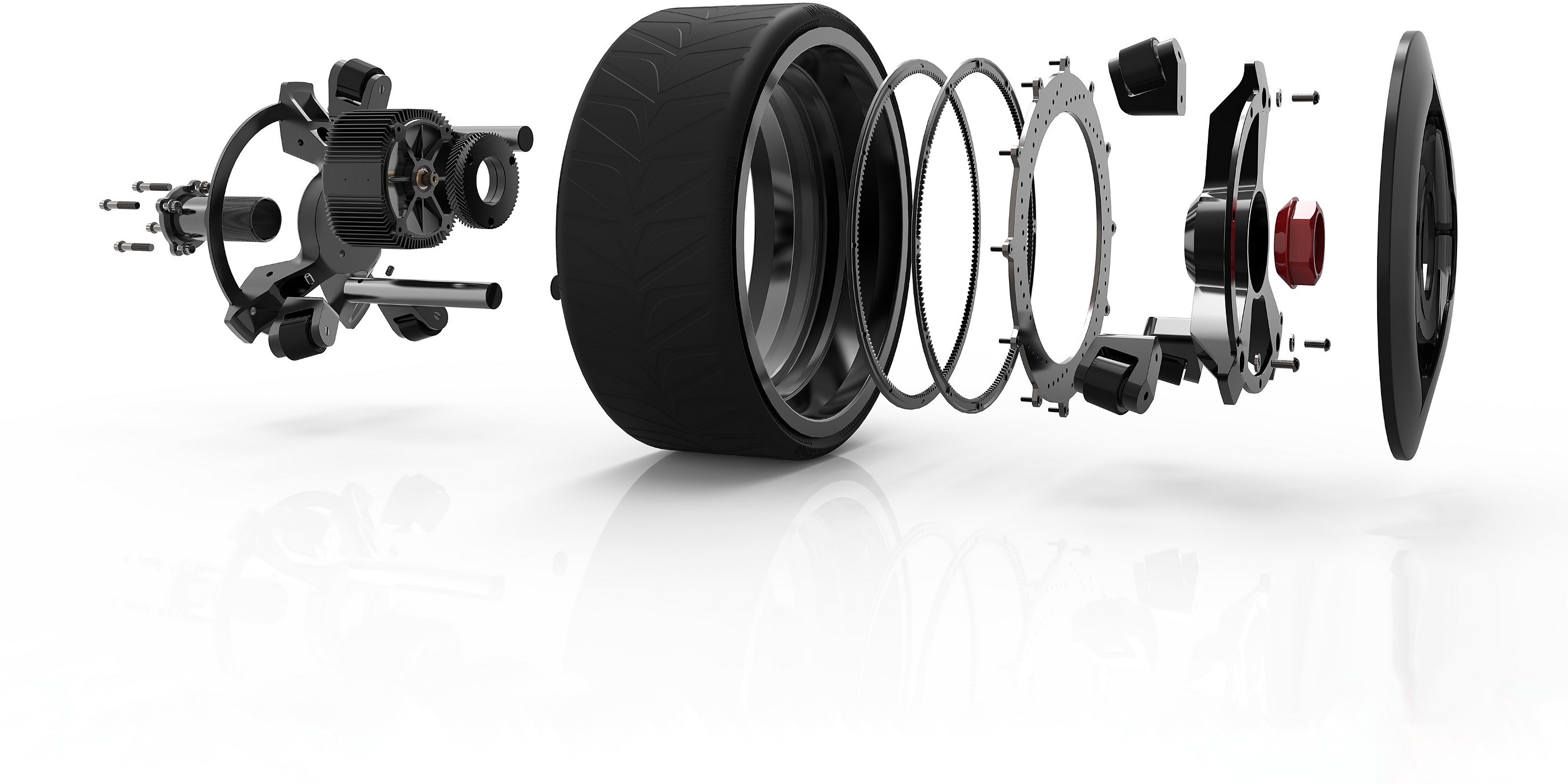 Orbis Ring Drive Hub Motor Deconstructed (source)
Orbis Ring Drive Hub Motor Deconstructed (source)
You can read more about potential market trends for 2025 for in-wheel motors here: Open PR Motor Study
Recently, Argonne announced a new technology that ?increases the usable magnetic flux density of a permanent magnet by 10 to 30 percent, leading to a significant improvement in the energy efficiency of electric motors and wind turbine generators.?
All of these technologies are very promising, and we will likely see some mix of the various innovations in our future vehicles that will change the way they look and feel.
4. Solid State Batteries
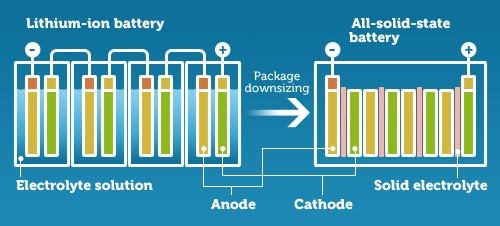 Lithium-Ion vs Solid-State Battery (source)
Lithium-Ion vs Solid-State Battery (source)
Batteries, namely Lead-Acid batteries, have been around since 1859. In 1884, the first production battery-electric vehicle (BEV) was built.
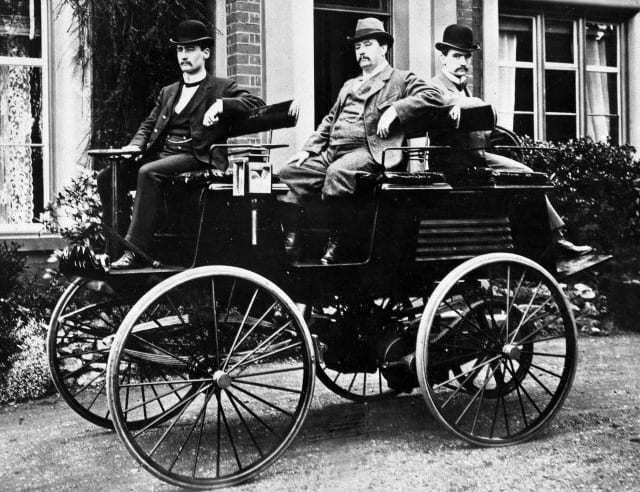 Thomas Parker?s 1884 Battery Electric Vehicle (source)
Thomas Parker?s 1884 Battery Electric Vehicle (source)
Lead-Acid batteries have lots of inherent problems. They are heavy (low energy-to-weight ratio), and they are physically large (low energy-to-volume ratio). They don?t have that much actual current capacity, despite what they may be rated for, because if you drain the battery much beyond 50%, the life cycle of the battery dramatically reduces. If you drain the battery below 20%, it may never be able to hold a charge again. Lead-Acid batteries also don?t have very many charge cycles they can take, and they charge very slowly.
With all these negatives of Lead-Acid batteries, scientists and engineers developed ?Lithium-Ion batteries.? Lithium-Ion batteries solve many of the issues of Lead-Acid batteries. They are smaller and lighter for the same voltage and amp-hours. They can discharge to nearly 100% of their capacity. They last longer (more charge cycles). They are even safer for the environment. They do tend to cost more than Lead-Acid batteries though.
 Lithium-Ion Battery Charge/Discharge (source)
Lithium-Ion Battery Charge/Discharge (source)
Despite all the advantages of Lithium-Ion batteries, their shortcomings are still the main reasons why many people won?t switch over to electric vehicles. To get the same range as an Internal Combustion Engine (ICE) Vehicle, all else considered, you?d need a battery that weighs significantly more than a tank of gas. That battery would also be substantially larger than that tank of gas. And worst of all to most consumers, that battery still takes an hour to fully charge on a Tesla Supercharger, longer for other types of chargers.
But there is hope. What if you could have a battery that?s as small as a gas tank, weighs a similar amount as a full one, and charges in only a few minutes? That?s where solid-state battery technology comes in. Not only does this technology promise an energy density 2.5x what we find in Lithium-Ion batteries, but it comes with extremely fast charging capability and as a bonus, is not flammable like gas or liquid batteries.
The downside? Solid-state batteries, in the current state of technology, are prohibitively expensive to produce. Back in 2012, it would have cost $100M to make a solid-state battery system capable of powering a high-end electric car. Additionally, there are concerns about low temperature performance and mechanical durability.
This hasn?t stopped major technology and vehicle giants from investing heavily into solid-state battery technology. Volkswagen invested $100M in a Solid-State Battery firm called QuantumScape in 2018, in anticipation of putting solid-state batteries in production vehicles by 2025. Samsung and Hyundai invested $20M in Solid Power, a Colorado-based startup backed by BMW that should be operational this year (2019). Caterpillar invested in an electric car startup, Fisker, that promises a vehicle with 500 miles range and 1-minute charging, with their battery technology being available before 2023.
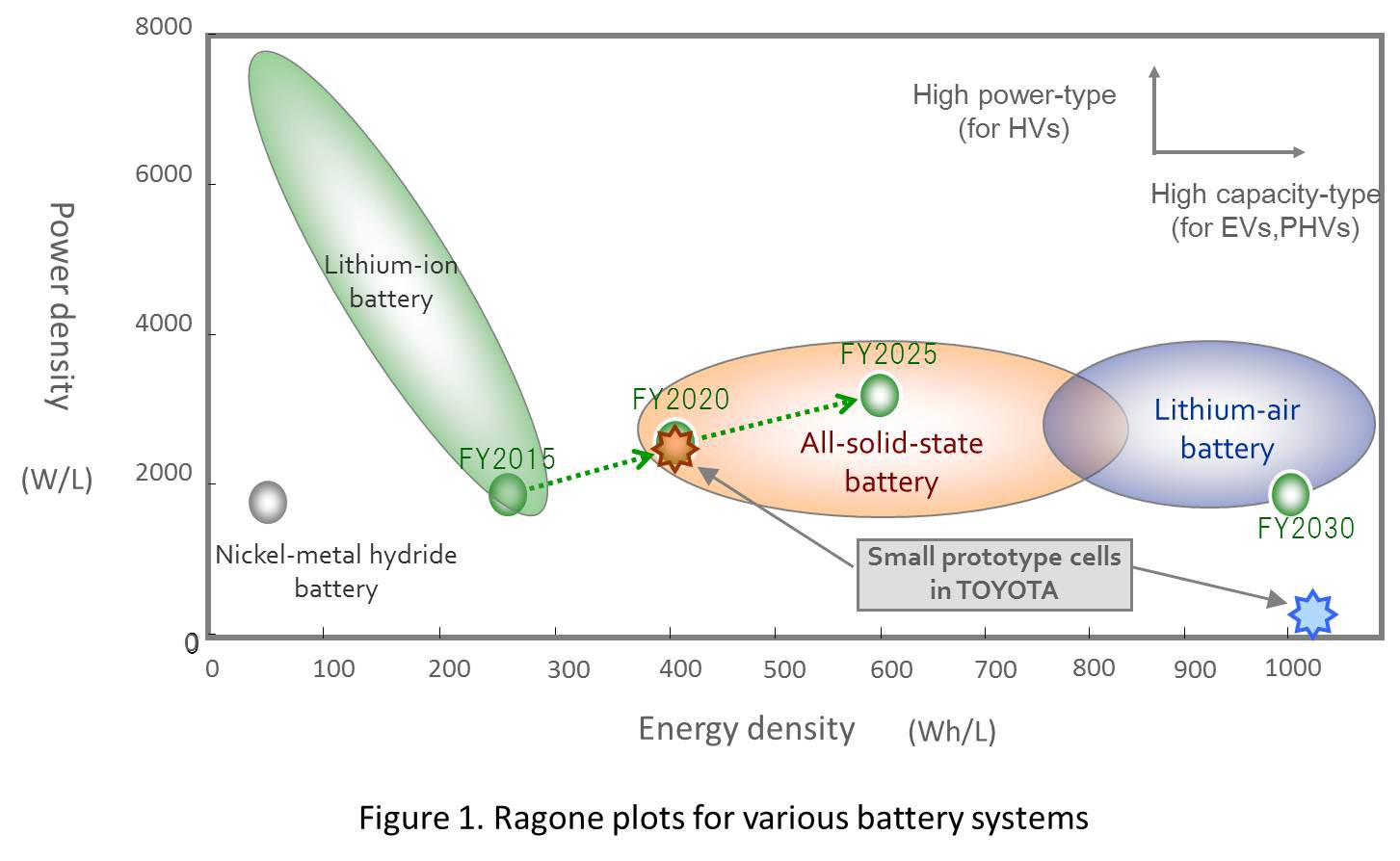 Toyota?s Plans for Solid State, and eventually Lithium-Air Batteries (source)
Toyota?s Plans for Solid State, and eventually Lithium-Air Batteries (source)
What would hold you back from buying an electric vehicle if charge time was under 1-minute, and you could have full-torque from the get-go?
5. Electric Charging Technology
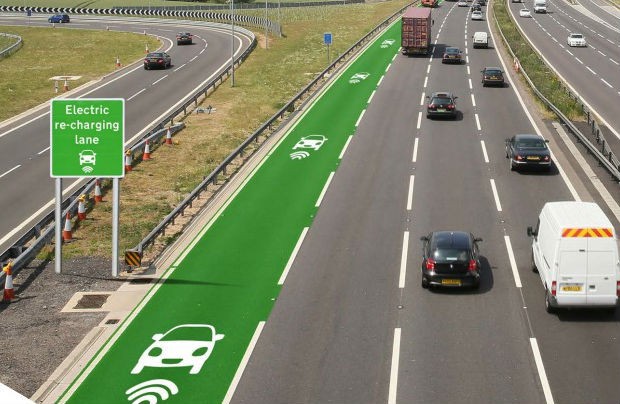 Hypothetical Wireless EV Car Charging Lane (source)
Hypothetical Wireless EV Car Charging Lane (source)
As of mid-2018, there were 18,000 charging stations on the road in the US. To keep up with the expectations for electric vehicles set by the Paris Agreement, the Center for American Progress estimates that we?ll need to add an additional 330,000 stations by 2025 (source).
This all relies on the growth of electric vehicles. But in a classic chicken-egg scenario, one of the leading detractors for vehicle-buyers of electric vehicles is their charge time. Sure, solid state batteries, smaller vehicles, and smaller and more efficient motors will alleviate some of this pain. But advancements in electric chargers and electric charging infrastructure is necessary for us to see true fast-charging that rivals a gas tank fill-up.
Like the SAE levels of autonomy, the SAE also defines levels of charging:
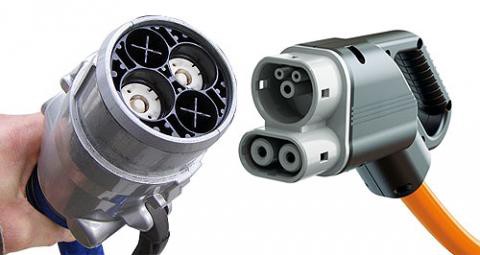 CHAdeMO 2.0?s 400kW Proposed Connector (source)
CHAdeMO 2.0?s 400kW Proposed Connector (source)
Combined Charging System 2.0 charging systems have the capability to charge up to 350 kW. Tesla?s Superchargers are capable of charging at up to 120 kW, but Elon Musk has spoken about getting 200?250 kW capability out soon. Then again, he also previously spoke about his plans to have 350 kW chargers, so who knows?
Swiss company ABB?s Terra High Power DC fast Charger (350 kW) just launched, and they?ve got a history producing both CHAdeMO and CSS chargers. One YC Startup, GBatteries, just came out of stealth to announce they have an electric car charger that ?lets you charge your car as quickly as visiting a pump.
Another technology that looks promising is wireless, or induction charging. This is comparable to wireless phone charging, but at significantly higher power. Qualcomm Halo has been working on a 22kW wireless charger for Formula E Series races since 2012. They?ve taken this even farther, and have discussed the possibility of charging vehicles while they drive up to 70 mph. This technology might enable us to never even have to stop at a gas station.
Nissan, Mercedes Benz, and BMW have all communicated wireless charging capability in their vehicles in the past. Volvo just announced an investment into Momentum Dynamics, who have communicated intentions for 300 kW over-the-air charging.
You may also remember the ?battery swap? technology that Tesla popularized in 2013. A number of companies have worked n this since, including Voltia, BattSwap, Gogoro Energy Network, and Better Place. This technology never really took off due to criticism for relying on proprietary battery technology and mechanical workings.
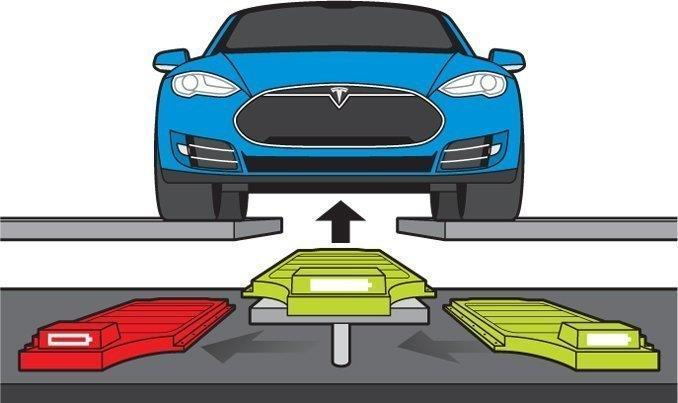 Tesla?s Battery Swap Proposal (source)
Tesla?s Battery Swap Proposal (source)
Likely, we?ll see some immediate advancements in cabled charging speeds, and some wireless charging taking off in the coming years. But both technologies require a huge infrastructure adjustment, that would take years, and 10s-of-billions of dollars, to implement.
 Estimated Number of Chargers Needed (source)
Estimated Number of Chargers Needed (source)
For one, our electrical grid needs to allow for the much higher power. Beefier cables, more stations, more safety regulations. McKinsey estimates that demand for electrical power for EV charging could increase from 20-billion kWh/yr in 2020 to 280 kWh/yr in 2030. Some of the biggest challenges may be in getting high powered EV chargers to remote locations. Though it does seem that the majority of EV charging will occur in the home.
 EV Charging Scenarios (source)
EV Charging Scenarios (source)
6. Sensors for Perception
 LiDAR Point Cloud Data Showing Velocity of Object (source)
LiDAR Point Cloud Data Showing Velocity of Object (source)
Cars today ?see? the road around them to accomplish various tasks. From backup cameras, parallel parking sensors, adaptive cruise control, and automatic emergency braking; all these capabilities rely on the vehicle perceiving the world. Perception sensors fall into roughly four cases: Cameras, LiDAR, Radar, and ultrasonic sensors.
Camera technology continues to improve. Cameras are getting smaller, faster, higher performance, and less expensive. But only recently have camera processing units been able to decipher 3D images from camera. This technology could be very useful in vehicles, for things like detecting curbs and potholes.
DeepRay has even created a technology that allows vehicles to see in rain and snow, through the use of AI to ?reconstruct footage from damaged or obscured frames in real-time.
 DeepRay?s AI Unobscuring a Fish Tank Image (source)
DeepRay?s AI Unobscuring a Fish Tank Image (source)
LiDAR sensors have been in the news plenty lately. Here?s a great Market overview of LiDAR companies. In short, everyone?s looking to make the perfect LiDAR sensor: one that can see 200 meters up to an inch precision, use only 100 mW of power, and costs less than $500. Most companies working on LiDAR are investing in ?solid state? LiDAR technology that has no moving parts. Some companies are even working on a LiDAR sensor that can determine the velocity of the object it detects. This is sometimes referred to as ?4D LiDAR,? or ?FMCW? LiDAR, and one company, Aeva, recently raised a $45M series A to develop this technology.
Automotive Radar has been around for quite some time, and is often used for advanced driver-assistance systems (ADAS). Radar is advantageous as a vehicle sensor since it is low cost and computationally simpler than other sensors. The big trend we?ll see in the coming years is the widespread adoption of automotive radar, since the Euro-NCAP ratings now require automated braking and pedestrian safety functionality, and radar is a good fit for this capability.
Companies will continue to develop software that ?fuses? these different sources of visual data and ?categorizes? the objects it detects. That categorization will be able to localize those objects and predict where they will go next. This is key for autonomous vehicle safety. We will see huge advancements in this capability from companies like Waymo, Cruise, Aptiv, Apple, and many others.
 Representative Sensor Fusion between camera, LiDAR and Radar (source)
Representative Sensor Fusion between camera, LiDAR and Radar (source)
7. Wireless Technology
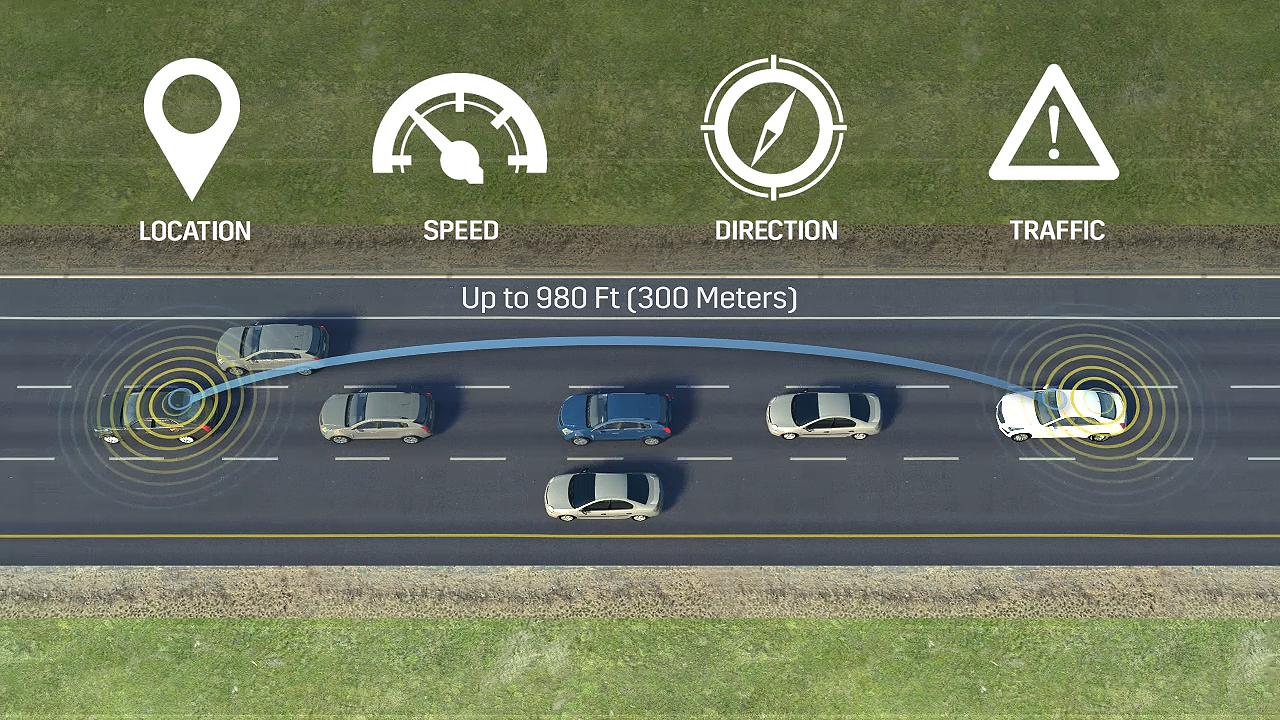 Cadillac?s V2V Diagram (source)
Cadillac?s V2V Diagram (source)
There?s been lots of speculation around how autonomous vehicles will communicate with one another, infrastructure, streets, people, and cities. The buzz words you?ll hear most often related to this is ?V2V,? or vehicle-to-vehicle wireless, ?V2I,? or vehicle-to-infrastructure, ?V2N,? or vehicle-to-network, ?V2P,? or vehicle-to-people, and ?V2X,? or vehicle to everything communication. There?s been lots of investment into technologies supporting V2V/I/N/X, and they generally fall into one of four buckets: Cellular (like LTE), Connectivity (Wifi and Bluetooth), Proprietary/Automotive-only Networks, and 5G.
 V2P/N/V/I Diagram (source)
V2P/N/V/I Diagram (source)
Toyota and Lexus announced they will get V2V/V2I tech starting in 2021, and Volkswagen in 2019.
Qualcomm has been building Cellular V2X chips for about a year now, and have announced rollouts in 2019. Intel has doubled down on 5G for connected vehicles. NXP created the first high-performance and automotive qualified single chip DSRC modem (DSRC is an automotive-specific short range protocol). Here?s six other startups working on the same thing.
V2X chips are expected in every new vehicle by 2023. This is a technology we can all bet on, we just don?t know which protocol will win out, or if automakers will standardize on a specific protocol so vehicles or infrastructure from different OEMs and developers can talk to one another.
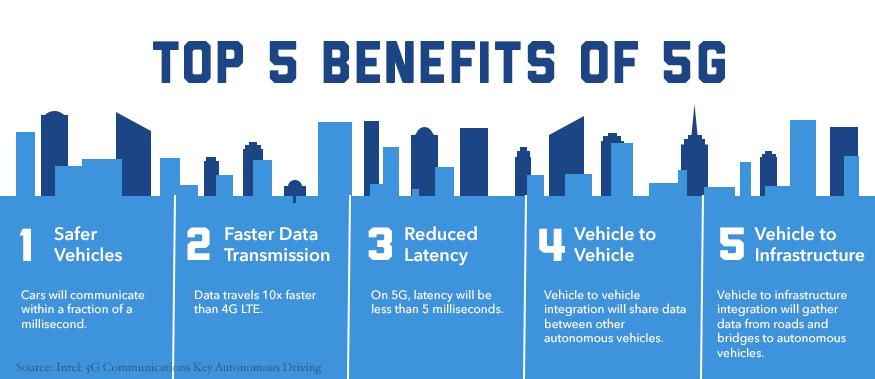 One Take on the Benefits of 5G for AVs (source)
One Take on the Benefits of 5G for AVs (source)
8. Automotive Materials and Manufacturing Processes
 World?s First 3D Printed Car by Local Motors (source)
World?s First 3D Printed Car by Local Motors (source)
The many materials that comprise our modern vehicles are modern marvels themselves. From the complex rubber and fiber compounds that make our tires stick to the road while lasting 100,000 miles, to the compressible many-alloy aluminum, magnesium, and steel impact zone on the front of our cars that save our life in the event of a crash. New automotive materials are continuously being developed and tested for future vehicles.
A number of materials have been broadcasted by automakers as potentially groundbreaking, such as:
- Coconut Husks
- Carbon Nanotubes
- Carbon Fiber
- Aerogels
- Bamboo
 Concept Car Made from Bamboo (source)
Concept Car Made from Bamboo (source)
Polymers and plastics offer unique benefits to the industry, namely because of their light weight, recyclable characteristics, abundance, and durability. One tier 1 provider, Faurecia, developed an innovative taillight assembly combining plastics and carbon fiber, reducing the product?s weight by 35%.
As for the manufacturing processes enabling these materials to be leveraged, I believe SQ Group?s Article said it better than I could ever:
Cold formed steel is still the industry standard for manufacturing automotive parts, but, high-strength materials are the future.
Some of the innovative manufacturing processes what will redefine automotive parts include:
Hot Formed Steel: Increasing the heat of steel improves ductility and helps form complex shapes without cracking.
Warm Formed Aluminum: Aluminum require less heat but follow a similar logic to heating steel.
High Pressure Thin Walled Aluminum Die Casting: Aluminum?s high melting and solidifying temperature points mean that thin aluminum molds need to be filled quickly before temperatures cool. This creates the need for high heat, high pressure manufacturing processes.
Resin Transfer Molding: Resins are pumped at high pressure into molds where they meet a pre-inserted fibre preform. This transforms light preform materials into high-strength automotive parts.
3D Printing: 3D printing offers manufacturers the opportunity to develop prototypes and full-scale parts that are significantly more complex than possible when forming or molding.
Source: CAR Research-Automotive Technology Roadmaps (2017)
3D printing has become popular for prototyping and developing small parts for many years. However, with the 3D printing process becoming much more controlled and cost effective, we?ve begun seeing a trend in 3D printing components of vehicles. Modern, large-scale printers can print large plastic panels, and Rolls Royce?s phantom has many parts of its interior consisting of 3D printed panels:
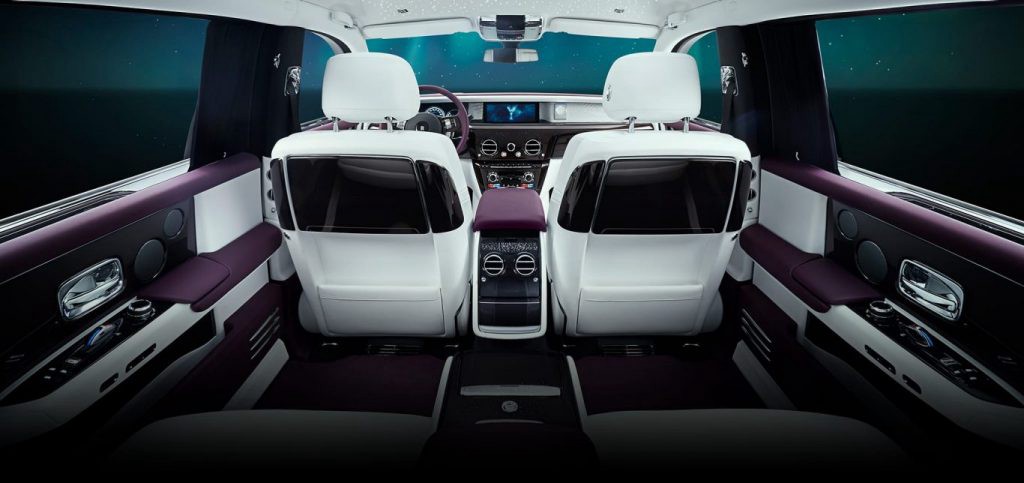 Interior of 2018 Rolls Royce Phantom (source)
Interior of 2018 Rolls Royce Phantom (source)
Metal 3D printers have become more popular as well, and Audi has made plans to begin printing many components of its vehicles in its new 3D printing center in Ingolstadt.
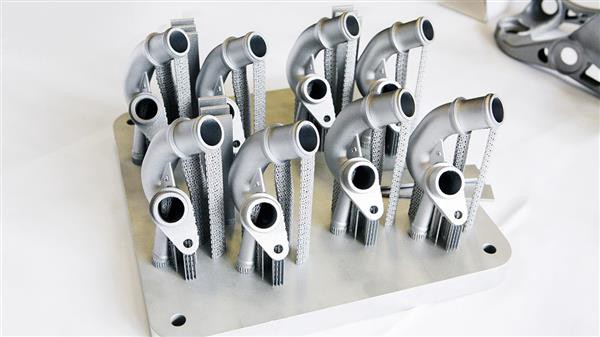 3D Printed Metal Water Connectors from Audi?s W12 Engine (source)
3D Printed Metal Water Connectors from Audi?s W12 Engine (source)
9. Fully-Active Suspension
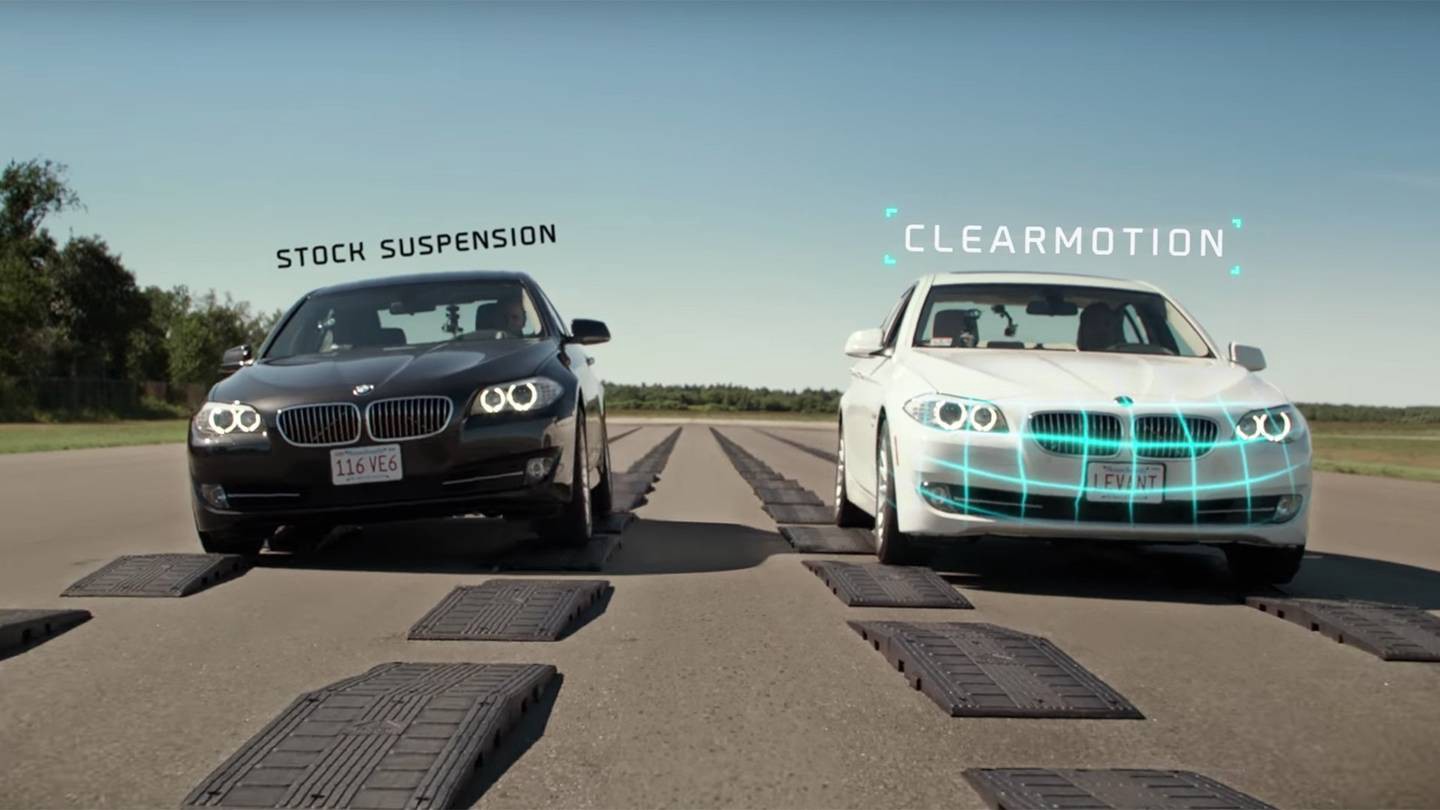 ClearMotion?s Fully Active Suspension (source)
ClearMotion?s Fully Active Suspension (source)
?You?ll be able to do so much more during your commute when vehicles are autonomous, like read, watch TV, and work!?
Well, not if you get motion sickness in vehicles. Companies like ClearMotion, born out of the speaker company Bose, are solving this problem. They are taking a proactive approach to suspension, by predicting road disturbances and adjusting the suspension in anticipation of them.
This follows a principle called ?skyhook theorum,? where vehicles will ride as if they?re airplanes. This will allow us to travel in extreme comfort. Companies like Mercedes and Audi have developed active suspension components, like ?Active Body Control,? but these are not quite fully active.
?Fully active? entails using linear actuators, rather than solely springs and dampers, for suspension. This requires significant computation power and electrical energy to predict and adjust the actuated suspension, and has traditionally been deemed impractical.
 ClearMotion Suspension System (source)
ClearMotion Suspension System (source)
However, with advancements in electric vehicles and AI software/hardware, ClearMotion has announced its plans to ship a product this year (2019)!
10. Purpose-Built Enabling Technologies
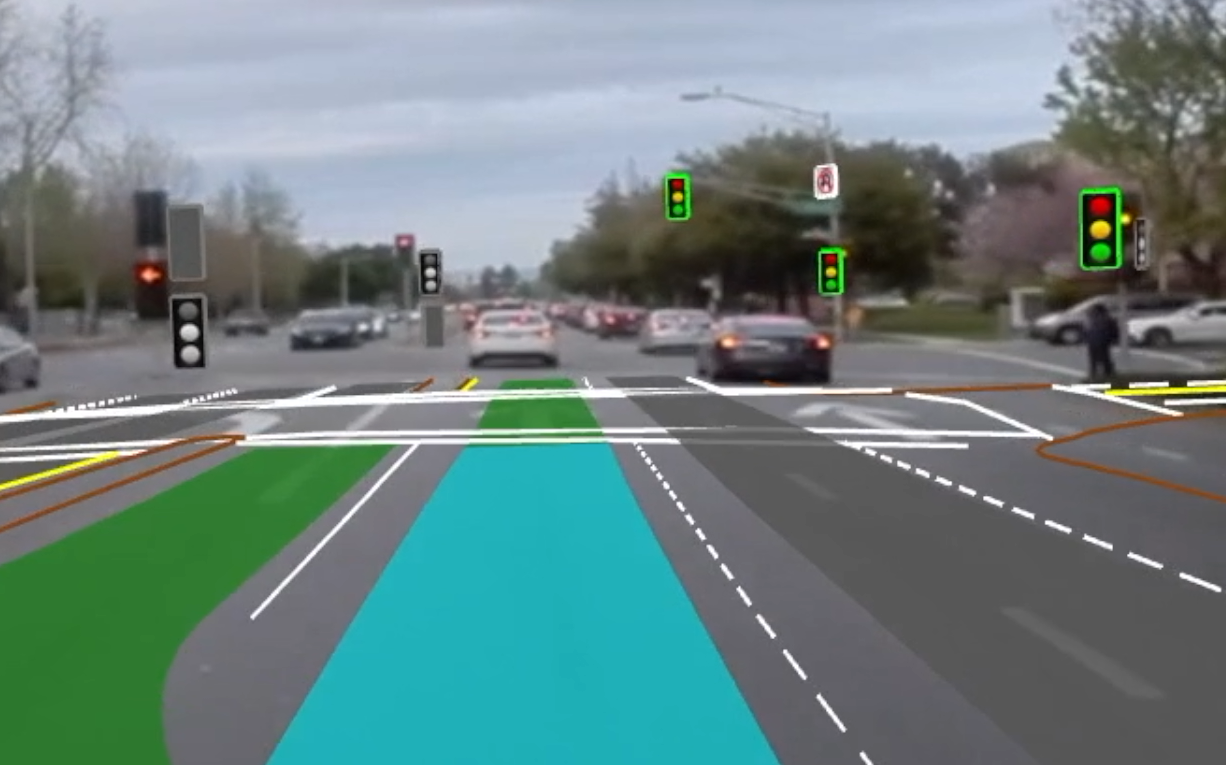 Civil Maps, an Edge-based HD Mapping and Localization Platform Company (source)
Civil Maps, an Edge-based HD Mapping and Localization Platform Company (source)
With all these new technologies abound, it?s safe to assume there will be a number of new suppliers to OEMs (Tier 1s) and suppliers to those suppliers (Tier 2s), and so-on down the line. These companies will develop ?enabling technologies? that ultimately helps create the vehicle of the future.
Here?s a few examples of such enabling technologies we might see in the future:
- Semiconductor manufacturing process for LiDAR
- Software platform for autonomous ride sharing service
- Predictive maintenance service for autonomous fleets
- An ?Underwriters Laboratory? for autonomous safety
- Self-balancing algorithms for personal pods
- Completely new infrastructure designs for autonomous fleet vehicles
We hardly remember any millionaires from the California Gold Rush, but millions of people wear Levi Strauss? Jeans he developed for miners. It may turn out that the big winners in the next 10 years aren?t the companies mining for ?gold,? but rather the companies that build the best ?pickaxes.?
 Nuro?s Self-Driving Delivery Platform (source)
Nuro?s Self-Driving Delivery Platform (source)


